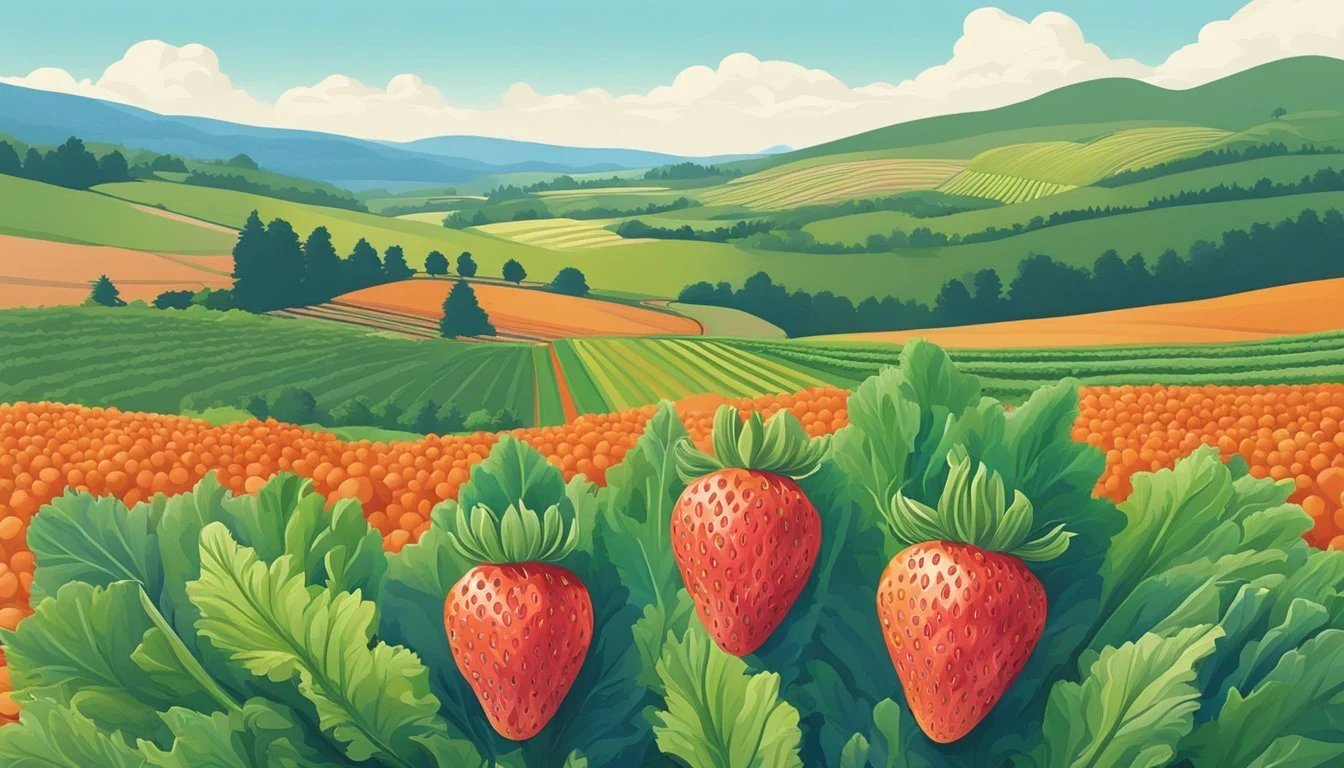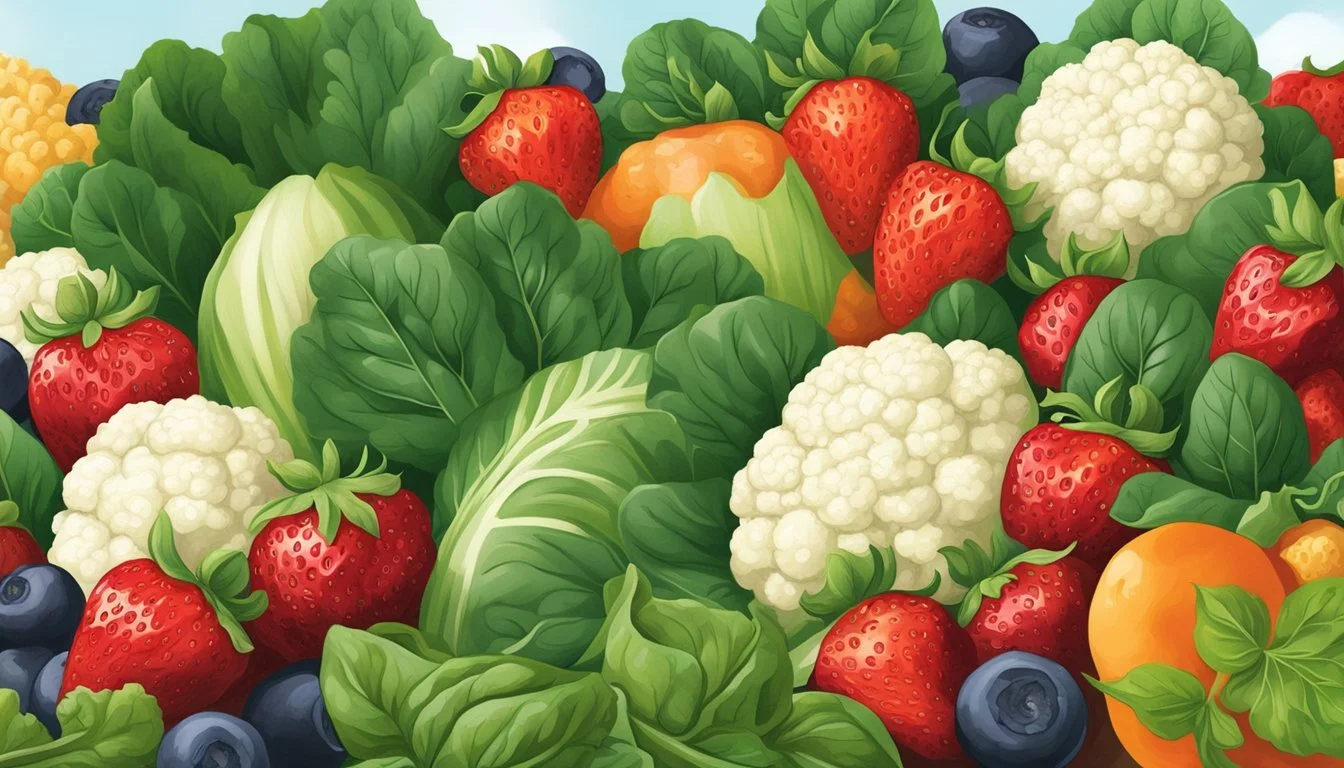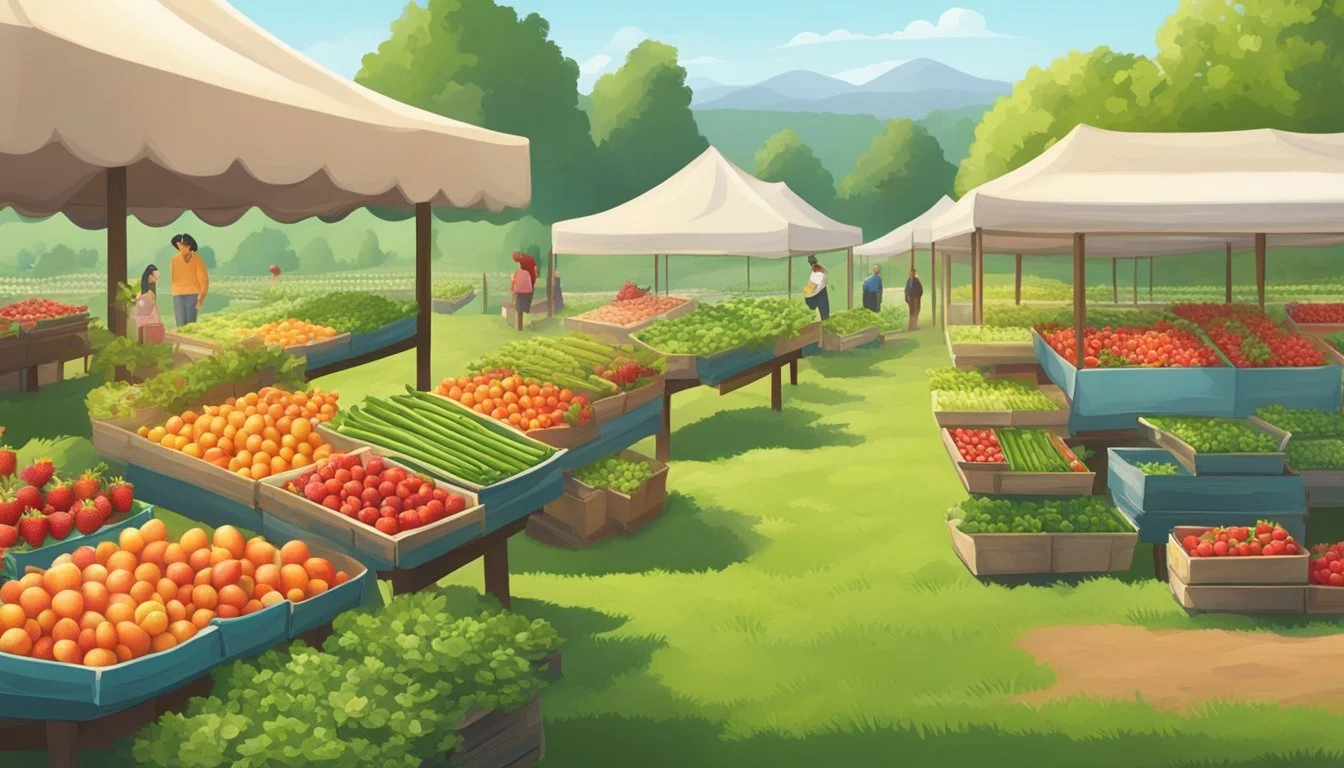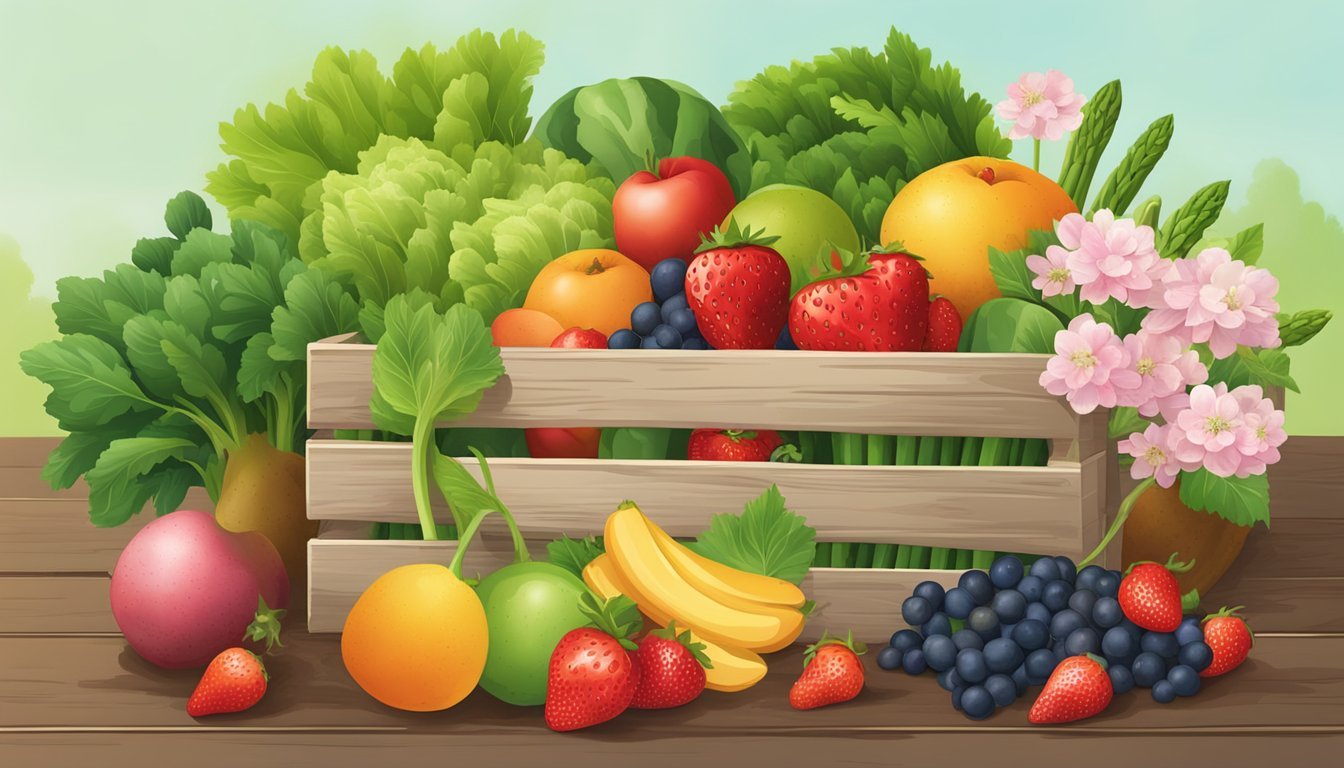Virginia Seasonal Fruit & Vegetables in March
A Guide to Fresh Produce Selection
This Article is Part of our Virginia Seasonal Fruit & Veg Calendar
In the diverse climate of Virginia, March brings the initial signs of spring and the start of a fresh produce season. While many summer fruits and vegetables are not yet in season, this month offers its own variety of locally grown options. Virginia's agricultural bounty begins to awaken, providing consumers with a selection of produce that is limited but cherished for its freshness and flavor.
Seasonal availability guides detailing what's in season suggest that during this transitional month, the options, while fewer, are still distinct. Root vegetables and hearty greens typically withstand the cooler temperatures of March. Shoppers at Virginia's local produce markets and grocery stores will find an array of produce items that thrive in this time of year.
Although the ground may still be thawing, some of the state's farms offer produce that has been overwintering, ready to be harvested. Greenhouses and cold frames also begin to yield vegetables like leafy greens and herbs. Embracing the seasonal produce available in March not only supports local agriculture but also encourages a diet that reflects the natural growing cycle of the region.
Overview of Virginia's Seasonal Cycles
Virginia's diverse climate allows for a variety of fruits and vegetables to grow throughout the year, each peaking in its corresponding season.
Understanding Seasonal Produce
In Virginia, seasonal produce refers to fruits and vegetables that are at their peak of freshness and flavor during certain times of the year. This cycle is influenced by local weather patterns and soil conditions unique to the region. Consuming seasonal produce ensures that one is enjoying these items when they are most nutritious and delicious.
The Progression of Seasons in Virginia
Virginia experiences four distinct seasons, each bringing its own array of produce:
Spring: Marked by gradual warming, this season sees the emergence of tender greens and the first fruits. Asparagus (What wine goes well with asparagus?) and strawberries begin to appear, signaling the start of a bountiful growing season.
Summer: Characterized by warm temperatures, it is the peak time for a variety of fruits and vegetables. Berries, melons, tomatoes, and zucchini are abundant.
Fall: As the climate cools, Virginia's farms offer apples (how long do apples last?), pumpkins, and root vegetables. This is the time for a shift towards heartier produce that stores well through cooler months.
Winter: While growth slows, certain hardy vegetables like turnips and winter squashes are available, and some greenhouse-grown produce can still be enjoyed.
Virginia's Agriculture and Produce
Virginia's rich agricultural industry not only contributes to the local economy but also provides a variety of seasonal produce. The state's climate and resources make it conducive for farming numerous types of fruits and vegetables.
Importance of Local Farming
Local farming in Virginia plays a crucial role in sustaining the state's economy. Family-owned and small farms contribute significantly to the food system, supplying fresh, nutritious produce directly to consumers. Emphasizing on the seasonality and sustainability, these local farms reduce the carbon footprint associated with long-distance transportation and reinforce the local food network.
Notable Facts:
Local produce often reaches consumers faster than items shipped from distant locations, ensuring freshness.
Community Supported Agriculture (CSA) programs and farmers' markets encourage Virginians to eat seasonally and support local livelihoods.
State's Agriculture Overview
The Virginia Department of Agriculture and Consumer Services (VDACS) oversees the state's agricultural activities, ensuring that high standards are met and the various regions are optimally utilized for agricultural purposes. Virginia's temperate climate allows for a diverse range of products, including a variety of fruits and vegetables that come into season throughout the year.
Peak Harvests in March:
Asparagus: Begins to appear towards the end of March.
Greens/Spinach (What wine goes well with spinach?): Cool weather makes for ideal growing conditions.
Agricultural Facts:
Virginia features a wide range of microclimates, allowing a variety of produce to be grown.
The coordination between various agricultural sectors helps maintain the consistent quality of Virginia-grown produce.
What's In Season in March
In March, the state of Virginia begins to see an array of fresh and delicious fruits, vegetables, as well as greens and herbs that thrive in the cool yet transitioning weather of early spring.
Fruits Available in March
Apples: While the main harvest occurs in the fall, storage apples are still crisp and available.
Vegetables Available in March
Broccoli: This versatile vegetable is coming into season, offering its rich, green florets.
Cabbage: Cabbage is hardy and available; it's perfect for stews and slaws.
Cauliflower: Similar to its cruciferous cousin broccoli, cauliflower peaks in flavor.
Mushrooms: Though not a plant, Virginia-grown mushrooms are plentiful in March.
Spinach: Tender and flavorful, spinach is a leafy green that's ready for picking.
Herbs and Greens in March
Greens: A variety of greens including collards are in season, adding nutrients and color to meals.
Peas: While they start to appear in March, peas are often more plentiful as spring progresses.
Asparagus: This springtime favorite begins to emerge and will become more widely available as the season goes on.
March Planting Tips for Virginia Gardeners
March ushers in the start of the planting season in Virginia, where gardeners can take advantage of the mild weather to prepare their gardens and plant a variety of crops.
Preparing for Spring Planting
One should commence soil preparation as early as March by ensuring a well-draining and fertile soil environment. It is advisable to conduct soil testing at this time if one hasn't done so recently. The soil test results will guide the gardener in amending the soil with the appropriate nutrients or pH adjustments.
Virginia gardeners should:
Clear the garden of weeds and debris.
Work organic matter, such as compost or well-rotted manure, into the soil.
Check for and repair any damage to garden infrastructure like fences, trellises, and raised beds.
Recommended Crops to Plant in March
The following list outlines crops suitable for planting in March in Virginia, along with additional planting considerations:
Vegetables Planting Notes Arugula Direct sow outdoors; thrives in cooler temperatures. Beets (how long do beets last?) Sow directly into well-worked soil; requires consistent moisture. Fennel (how long does fennel last?) Sow outdoors; can benefit from cloche protection if needed. Lettuce Ideal for sowing directly; select varieties that tolerate cool temperatures. Radish Quick to mature; direct sow outdoors for a fast harvest. Snap Peas Plant in soil enriched with compost; provide support for climbing. Parsnips Sow directly; requires deep, stone-free soil.
Herbs like sage should also be considered; they can be started from seeds indoors or planted outside as transplants.
Cooler temperatures make it suitable to begin seeding tomatoes and peppers indoors, in preparation for transplanting once the risk of frost has passed. Keep these indoors in a warm area until they are strong enough to withstand outdoor conditions.
Sweet potatoes (What wine goes well with sweet potatoes?) are typically not planted in March, as they require warmer soil temperatures and are usually reserved for planting a bit later in the spring.
Following these tips should assist Virginia gardeners in making the most of their March planting opportunities, setting the foundation for a bountiful growing season.
Seasonal Recipes and Flavor Pairings
In March, Virginia's seasonal produce is robust with flavor and versatility. Early spring ushers in the last of winter's bounty and the beginning of fresher tones. Chefs and home cooks alike explore this transitional period through creative recipes and flavor pairings that highlight the season's best.
Vegetables: Hardy greens like kale and cabbage thrive in the cool Virginia March. These leafy vegetables pair well with rich dressings or acidic citrus notes to balance their earthiness. Cabbage, for instance, becomes a vibrant side dish when sautéed with garlic and lemon.
Kale Salad: Toss kale with olive oil, lemon juice, and a hint of honey. Add roasted pine nuts (how long do nuts last?) for a nutty crunch.
Braised Cabbage: Braise cabbage in apple cider vinegar with sliced apples and onions for a sweet and tangy side.
Root Vegetables: Potatoes and leeks are in abundance and their comforting flavors lend themselves to warming dishes.
Potato-Leek Soup: Combine these two vegetables with herbs like thyme to create a silky soup, perfect for chilly March evenings.
Roasted Potatoes: Roast with rosemary and a sprinkle of sea salt (how long does sea salt last?) for a simple, but satisfying dish.
Fruit: While strawberries may not be quite in season, late varieties of apples are still crisp and juicy. They give a sweet note to both savory and dessert dishes.
Apple-Cabbage Slaw: Mix julienned apples with shredded cabbage and a tangy vinaigrette for a crunchy salad.
Baked Apples: Core apples and stuff with a mixture of oats, cinnamon, and a touch of maple syrup for a healthier treat.
Herbs: Fresh herbs elevate the inherent flavors of any produce. Cilantro adds a fresh kick to citrusy dishes, while rosemary and thyme complement the earthy tones of March's root vegetables.
By employing these ingredients in their prime, one can create dishes that are a true reflection of the season in Virginia, capturing the essence of what it has to offer in terms of flavor and nutrition.
Monthly Produce Guide
March in Virginia marks a transitional period for local produce, as winter varieties reach their end and early spring vegetables begin to appear. Consumers and culinary enthusiasts can enjoy a variety of fruits and vegetables that are at their peak freshness.
Virginia Produce Calendar
In March, Virginians can expect to find the following produce at local markets:
Asparagus: Starting to come into season, asparagus is fresh and tender during this time.
Beets: These are available and offer earthy flavors, perfect for end-of-winter dishes.
Broccoli: Continuing from winter, broccoli remains available, providing a nutritious option.
Collard Greens (how long do collard greens last?): Still strong in March, collards offer a leafy green choice for consumers.
Chard: In season and versatile for a range of recipes.
Spinach: This leafy green starts to come into season, ideal for fresh salads or cooked dishes.
These items reflect the transitional nature of produce availability in Virginia, with a mix from the tail end of winter vegetables to the initial offerings of spring.
Comparative Availability by Month
A comparison of Virginia's produce availability by month sheds light on what consumers may expect as the seasons change:
Month Produce Available January Apples, Kale, Sweet Potatoes February Apples, Turnips March Asparagus, Beets, Broccoli, Collard Greens, Chard, Spinach April Strawberries, Lettuce May Strawberries, Cherries June Berries, Cucumbers July Peaches, Tomatoes August Corn, Peppers September Apples, Squash October Pumpkins, Greens November Sweet Potatoes, Winter Squash December Winter Squash, Turnips
The table highlights the shifting availability of certain produce before and after March, offering insights into the seasonal nature of Virginia’s agriculture.
Health Benefits of Seasonal Eating
Eating seasonal produce like greens, spinach, kale, mushrooms, and apples, which are available in Virginia during March, provides numerous health benefits. These foods are typically at their peak in terms of flavor, nutritional value, and freshness.
Greens: They are a rich source of essential vitamins and minerals. For example, kale is high in vitamins A, C, K, and minerals like calcium, while spinach abounds in iron and magnesium.
Mushrooms: Available wild or cultivated, mushrooms are a low-calorie source of fiber, protein, and antioxidants. They play a role in supporting the immune system and can be a delicious addition to a variety of dishes.
Apples: An apple a day can be part of a healthy diet year-round, thanks to storage technologies, but they are often harvested in the fall. Apples provide dietary fiber that supports digestion and can help in managing cholesterol levels.
Additionally, seasonal eating means produce is often harvested at peak ripeness, when it's most nutritionally dense. Seasonal fruits and vegetables might also contain more antioxidants at the time of harvest, compared to off-season produce that may have been picked early and stored for long periods.
Produce Key Nutrients Kale Vitamins A, C, K Spinach Iron, Magnesium Mushrooms Fiber, Protein Apples Dietary Fiber
By choosing seasonal foods, individuals can enjoy a diet that is diverse, nutrient-rich, and supportive of local economies. With a variety of options to choose from, March offers an opportunity to incorporate these healthful foods into meals.









